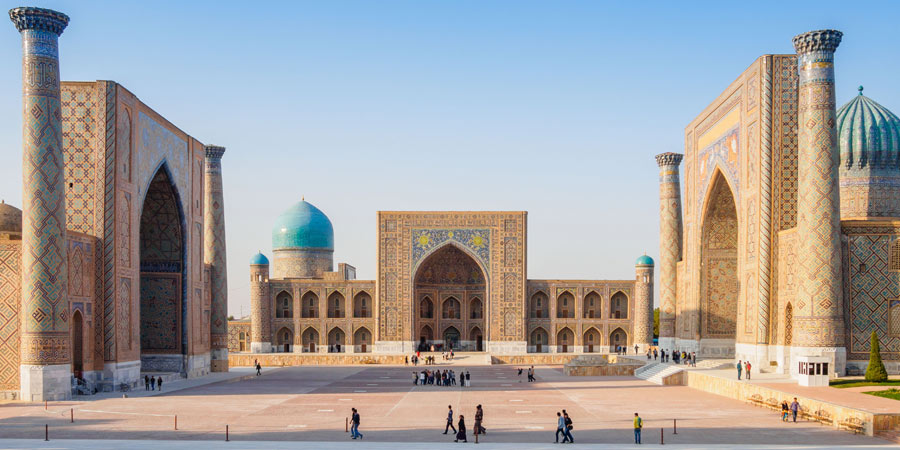Historically one of the most important cities in Central Asia, sprawling Samarkand was once a centre of commercial trade in the region, its sandy streets filled with wares of all kind and travellers from far and wide. Benefitting from its centralized location along the fabled Silk Road trading route between the Mediterranean and China, Samarkand fast became a centre of commerce and of prosperity.
In more current times, Samarkand is still one of Uzbekistan's largest and most populous cities, although its influence of global trade has waned somewhat. Its rich and tumultuous history is visible on every street however, with fantastic and varied architecture telling a story of the city's many influencers and conquerors over its long life. The city has been fallen under the realms of several of history's most important Empires, including the Seleucids and those of Alexander the Great and Genghis Khan. Samarkand's fantastic array of architecture and deep and engrossing history has seen it earn UNESCO World Heritage status and nowadays the streets are filled with tourists and visitors the world over.
Historically, Samarkand was an important destination on the Silk Road trade route due to its location as a half way stop. Traders from China first arrived in Samarkand in the 2nd century BC and began the trading of silk and the fabled local horses. With merchants flocking to the city from across Asia to sell their wares, the city grew in size and scale and began to attract the attention of those who sought to add its burgeoning economic power to their own empires. It was the 14th century Turco-Mongol conqueror Timur who had the most influence on shaping modern Samarkand, the first ruler of the Timurid Empire, he is more commonly referred to as Tamerlane.
The Timur dynasty are buried in Samarkand's Shah-i-Zinda necropolis. "The Living King", as is the English translation, is a collection of mausoleums and other ritual buildings dating as far back as the 9th century. A number of Samarkand's most important figures and dignitaries are buried within the necropolis' three structures but the central and inner-most tomb is saved for someone of even more importance to Samarkand than Tamerlane. Supposedly buried in the inner-most tomb is Kusam ibn Abbas, the cousin of the prophet Muhammad and one of the primary founders of Islam in Central Asia after the Arab Invasions of 7 B.C. Equally impressive is the Ulugh Beg Observatory, named after its eponymous founder, the fabled astronomer Ulugh Beg. First built in 1420, the observatory was one of the most important in the Islamic world, but was lost after its ransacking by religious fanatics in 1449, only to be rediscovered in 1908 by Uzbek archaeologists. The restored Bibi-Khanym Mosque possesses similar grandeur, in the late 15th century the vibrant building was one of the most impressive in the Islamic world and although the elegance of the architecture deteriorated somewhat over the centuries, it has recently been repaired and restored to its former glory.
The title of the most iconic building in Samarkand however goes to the world famous Registan, spend a few moments here and it is easy to see why. Formerly the centre of the city and a place of public meetings, proclamations and executions, the Square is flanked by three Islamic schools, known as madrasahs.
A melting pot of different cultural influences, ethnicities and beliefs, modern Samarkand is a jewel in the desert. From the jostling merchants of the city bazaars to the quiet reverence of the Samarkand mosques, the city is an elegant window into a long, rich and tumultuous history and is a fine addition to any travellers list of must see locations
Follow the footsteps of history and discover the opulence of bustling Samarkand with Great Rail Journeys on our brand new Silk Road to Samarkand escorted rail holiday experience.






